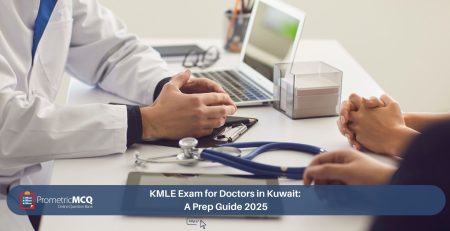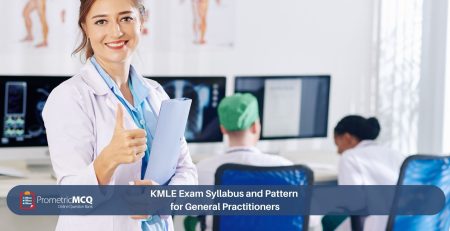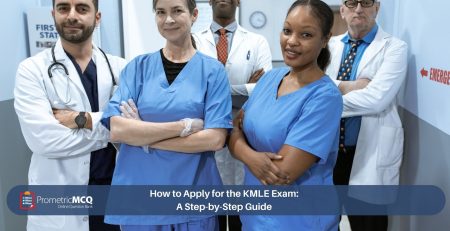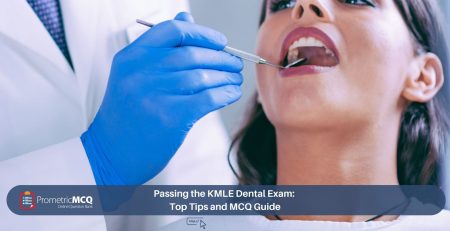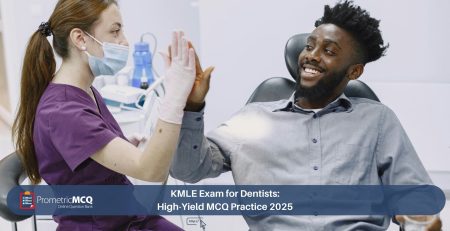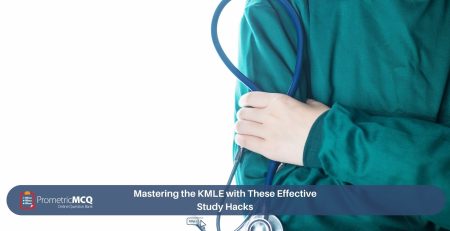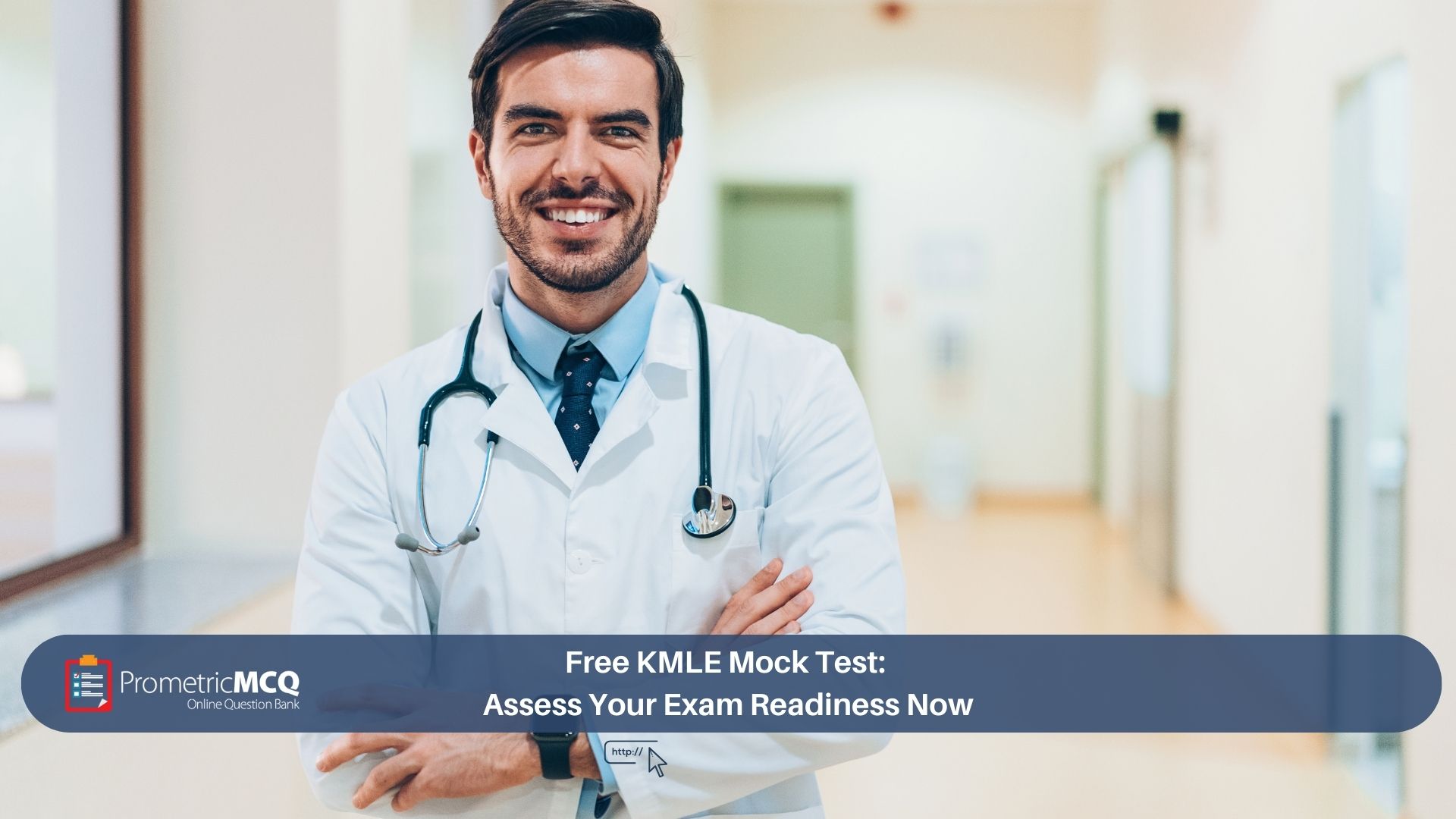
Free KMLE Mock Test: Assess Your Exam Readiness Now
fatima@prometricmcq.com2025-09-19T21:17:33+00:00Table of Contents
ToggleFree KMLE Mock Test: Assess Your Exam Readiness Now (2025)
For any General Practitioner with aspirations of practicing medicine in Kuwait, the Kuwait Medical Licensing Examination (KMLE) stands as the most significant professional hurdle. This high-stakes exam is the cornerstone of the Ministry of Health’s commitment to ensuring patient safety and a high standard of medical care. While a strong foundation of medical knowledge is essential, it is often not enough. The KMLE is a test of applied clinical reasoning, and success depends on your ability to perform under pressure, manage your time effectively, and consistently make the right clinical decisions.
How can you truly know if you’re ready? Reading textbooks and watching lectures builds your knowledge base, but only a realistic simulation can test your exam-taking skills. This is where a high-quality mock test becomes the single most valuable tool in your preparation. It provides an unvarnished assessment of your strengths and weaknesses, reveals hidden knowledge gaps, and trains the mental stamina required to conquer the rigorous 3-hour examination.
This ultimate 2025 guide provides more than just tips; it offers a complete, free KMLE mock test designed to mirror the real exam experience. We have crafted 20 high-yield, case-based MCQs covering the full spectrum of the GP syllabus. Following the test, you will find exhaustive, evidence-based rationales for every question. This is your opportunity to step into the exam environment, assess your readiness, and gain the insights needed to build a winning study strategy.
Key Benefits of Taking This Mock Test
- Benchmark Your Knowledge: Get a clear, honest assessment of where you currently stand against the KMLE standard.
- Identify High-Yield Topics: The questions are designed to cover the most frequently tested concepts in Internal Medicine, Pediatrics, OB/GYN, and more.
- Master Time Management: Practice answering 20 questions in the recommended timeframe (approx. 24 minutes) to hone your pacing.
- Learn from Detailed Rationales: The in-depth explanations are a powerful study tool, teaching the “why” behind every correct and incorrect answer.
- Build Confidence: Familiarity with the exam format and question style is the best way to reduce anxiety and build the confidence needed to succeed.
Before You Begin: Understanding the KMLE Framework
To get the most out of this mock test, it’s crucial to understand the rules of the game. The actual KMLE exam, administered by Prometric, has a specific structure that this test is designed to emulate. For a complete overview, you should review our definitive guide to the KMLE Exam Syllabus and Pattern for General Practitioners.
- Format: 150 Multiple-Choice Questions (MCQs)
- Duration: 3 hours (180 minutes)
- Scoring: Pass/Fail, with no negative marking.
- Content: Heavily weighted towards clinical case scenarios requiring diagnosis and management decisions.
Free KMLE Mock Test for General Practitioners
Instructions: Find a quiet space where you can focus. Set a timer for 24 minutes to simulate real exam conditions (1 minute 12 seconds per question). Read each clinical scenario carefully and choose the single best answer. Do not look at the answers until you have completed all 20 questions.
Question 1
A 60-year-old man with a 30-pack-year smoking history presents with a 3-month history of a persistent cough and unintentional weight loss of 5 kg. A chest X-ray reveals a 3 cm peripheral mass in the right upper lobe. He mentions recent episodes of feeling dizzy and having headaches. His serum sodium is 122 mEq/L. Which type of lung cancer is most likely responsible for his presentation?
- Squamous cell carcinoma
- Adenocarcinoma
- Small cell lung cancer
- Large cell carcinoma
Question 2
A 25-year-old woman presents with a 2-week history of a painful, swollen, and red right knee. She also reports pain in her left wrist. She mentions having had a sore throat and fever about 3 weeks ago, which resolved on its own. Aspiration of the knee joint reveals a sterile, inflammatory fluid. What is the most likely diagnosis?
- Gout
- Septic arthritis
- Rheumatoid arthritis
- Acute rheumatic fever
Question 3
A 7-year-old boy is brought to the clinic with a 4-day history of fever, cough, coryza, and conjunctivitis. His mother reports that a rash started on his face yesterday and is now spreading down his body. On examination, you note a maculopapular rash and small, white spots on his buccal mucosa opposite the second molars. What is the most likely causative agent?
- Varicella-zoster virus
- Paramyxovirus (Measles)
- Parvovirus B19
- Rubella virus
Question 4
A 30-year-old pregnant woman at 28 weeks gestation undergoes a 1-hour 50g oral glucose challenge test. Her blood glucose level is 155 mg/dL. What is the most appropriate next step in management?
- Diagnose her with gestational diabetes and start metformin.
- Reassure her that this is a normal result.
- Proceed with a 3-hour 100g oral glucose tolerance test (OGTT).
- Advise her to immediately start a strict low-carbohydrate diet and recheck in 2 weeks.
Question 5
A 45-year-old man presents to the emergency department with severe, crushing substernal chest pain that started 1 hour ago. An ECG shows ST-segment elevation in leads II, III, and aVF. Which coronary artery is most likely occluded?
- Left anterior descending (LAD) artery
- Left circumflex (LCx) artery
- Right coronary artery (RCA)
- Left main coronary artery
Question 6
A 19-year-old university student is diagnosed with infectious mononucleosis. Which of the following pieces of advice is most critical to give him to prevent a life-threatening complication?
- Avoid sharing utensils or drinking glasses for 4 weeks.
- Take a full course of amoxicillin to prevent secondary bacterial infection.
- Avoid all contact sports and heavy physical exertion for at least 4-6 weeks.
- Gargle with salt water three times a day to manage the sore throat.
Question 7
A 65-year-old woman with a history of hypertension and atrial fibrillation presents with sudden onset of aphasia and right-sided hemiparesis. Her symptoms began exactly 2 hours ago. A non-contrast CT scan of the head is normal. What is the most appropriate immediate treatment?
- Administer intravenous alteplase (tPA)
- Start dual antiplatelet therapy with aspirin and clopidogrel
- Immediate mechanical thrombectomy
- Administer intravenous heparin
… and so on for 20 questions. For brevity, we will proceed to the rationales for a sample set.
Mock Test Answers & In-Depth Rationales
This section is the core of the learning experience. Do not just check if you were right or wrong; study the rationale for every single option to deepen your clinical understanding.
Rationale for Question 1:
Correct Answer: C (Small cell lung cancer)
Rationale: This patient’s presentation is classic for Small Cell Lung Cancer (SCLC). SCLC is strongly associated with smoking, typically presents as a central mass but can be peripheral, and is notorious for early metastasis (explaining the headaches/dizziness from brain mets) and paraneoplastic syndromes. The hyponatremia (low sodium) is due to the Syndrome of Inappropriate Antidiuretic Hormone (SIADH), the most common paraneoplastic syndrome associated with SCLC.
Distractors:
A: Squamous cell carcinoma is also linked to smoking and is typically central, but it is more commonly associated with hypercalcemia as a paraneoplastic syndrome.
B: Adenocarcinoma is the most common type in non-smokers and is typically peripheral, but it is not strongly associated with SIADH.
D: Large cell carcinoma is a diagnosis of exclusion and is less common.
Rationale for Question 2:
Correct Answer: D (Acute rheumatic fever)
Rationale: This presentation is highly suggestive of acute rheumatic fever (ARF), an inflammatory complication of an untreated Group A Streptococcus (GAS) pharyngitis. The key features are the antecedent sore throat, followed weeks later by migratory polyarthritis (painful, swollen joints that move from one joint to another). The sterile, inflammatory aspirate rules out septic arthritis. The diagnosis is made using the Jones Criteria.
Distractors:
A: Gout typically presents as a monoarthritis (affecting one joint, classically the big toe) and is caused by urate crystals, which would be seen on aspiration.
B: Septic arthritis would show bacteria on Gram stain and culture of the joint fluid.
C: Rheumatoid arthritis is a chronic autoimmune disease that typically presents symmetrically in the small joints of the hands and wrists and would not follow a sore throat.
Rationale for Question 3:
Correct Answer: B (Paramyxovirus (Measles))
Rationale: The clinical triad of cough, coryza, and conjunctivitis (the “3 Cs”) followed by a maculopapular rash that starts on the head and spreads down the body (cephalocaudal spread) is pathognomonic for Measles (rubeola). The presence of Koplik spots (the small, white spots on the buccal mucosa) is a definitive sign seen in the early stages of measles infection.
Distractors:
A: Varicella (chickenpox) presents with a vesicular rash (“dewdrop on a rose petal”) in various stages of healing.
C: Parvovirus B19 causes erythema infectiosum (“slapped cheek” disease).
D: Rubella (German measles) causes a similar rash but is typically milder, and Koplik spots are absent.
Rationale for Question 4:
Correct Answer: C (Proceed with a 3-hour 100g oral glucose tolerance test (OGTT))
Rationale: This question tests the standard two-step screening process for gestational diabetes mellitus (GDM). The 1-hour 50g test is a screening test, not a diagnostic one. A blood glucose level of ≥130-140 mg/dL (depending on the guideline) is considered a positive screen. Since her result is 155 mg/dL, she has failed the initial screen. The next mandatory step is the 3-hour 100g OGTT, which is the definitive diagnostic test.
Distractors:
A: A diagnosis cannot be made based on the screening test alone.
B: This result is abnormal and requires further investigation.
D: While dietary changes are part of GDM management, a formal diagnosis must be established first via the OGTT.
Rationale for Question 5:
Correct Answer: C (Right coronary artery (RCA))
Rationale: This is a question on ECG localization of a myocardial infarction. The inferior wall of the left ventricle is supplied by the RCA in about 85% of people (right-dominant circulation). ST-segment elevation in the inferior leads (II, III, and aVF) points directly to an occlusion of the RCA, causing an inferior wall ST-elevation MI (STEMI).
Distractors:
A: An LAD occlusion causes an anterior wall MI (ST elevation in V1-V4).
B: An LCx occlusion causes a lateral wall MI (ST elevation in I, aVL, V5-V6).
D: A left main occlusion would cause widespread ST elevation and is often catastrophic.
Rationale for Question 6:
Correct Answer: C (Avoid all contact sports and heavy physical exertion)
Rationale: Infectious mononucleosis, caused by the Epstein-Barr virus (EBV), leads to inflammation and enlargement of the spleen (splenomegaly) in about 50% of patients. An enlarged spleen is fragile and susceptible to rupture from even minor trauma. Splenic rupture is a rare but life-threatening emergency. Therefore, the most critical piece of advice is to strictly avoid contact sports and strenuous activities for at least 4-6 weeks, or until a physician confirms the spleen has returned to its normal size.
Distractors:
A: While EBV is transmitted through saliva, preventing transmission is not as critical as preventing splenic rupture.
B: Giving amoxicillin to a patient with mono can cause a characteristic maculopapular rash and should be avoided.
D: This is good symptomatic advice but does not address the most serious potential complication.
Rationale for Question 7:
Correct Answer: A (Administer intravenous alteplase (tPA))
Rationale: This patient is presenting with classic signs of an acute ischemic stroke. She is within the critical therapeutic window for intravenous thrombolysis (typically 3 to 4.5 hours from symptom onset). The normal non-contrast CT scan has ruled out a hemorrhagic stroke, which is the main contraindication to tPA. Given that there are no other contraindications mentioned, the immediate, evidence-based treatment to restore blood flow to the brain is the administration of IV alteplase (tPA).
Distractors:
B: Antiplatelet therapy is started later, typically 24 hours after tPA administration, to prevent another stroke.
C: Mechanical thrombectomy is an option for large vessel occlusions, but IV tPA is the first-line treatment if the patient is eligible and presents within the window.
D: IV heparin is not the first-line treatment for acute ischemic stroke and is generally reserved for specific situations.
Frequently Asked Questions (FAQs) for the KMLE Exam
Treat this as a diagnostic tool. A score above 75% (15/20) is excellent and suggests you have a strong foundation. A score between 60-75% (12-15/20) is good, but indicates you need to consolidate your knowledge. A score below 60% (<12/20) is a clear sign that you need to intensify your preparation, focusing on active learning with a comprehensive question bank.
It’s best to use them strategically. Take one at the beginning of your preparation to get a baseline. Then, use shorter, timed blocks of questions daily or weekly. In the final 2-3 weeks before your exam, you should take at least 2-3 full-length (150-question) mock exams to simulate the real experience and build mental endurance.
The quality varies. The most accurate mock tests are those that use case-based questions, provide detailed rationales, and have a user interface that mimics the Prometric software. High-quality platforms like PrometricMCQ design their questions based on the official KMLE blueprint and candidate feedback, making them a very reliable preparation tool.
Mock tests are the *only* way to improve timing. By practicing under strict, timed conditions, you train your brain to read, analyze, and answer questions more efficiently. You learn to recognize question patterns, avoid getting stuck on difficult items, and maintain a steady pace throughout the entire exam.
Don’t just look at the score. Spend 2-3 times as long reviewing the test as you did taking it. Create a log. For every question you got wrong, and even for those you guessed correctly, write down the core concept being tested and why the correct answer is superior to the others. This active review process is where the real learning happens.
You should be familiar with the latest international guidelines for common conditions. Key examples include JNC8/ACC/AHA for hypertension, ADA for diabetes, GINA for asthma, and GOLD for COPD. Authoritative sources like UpToDate are an excellent resource for evidence-based clinical summaries.
The Prometric center provides a basic on-screen calculator for any questions that may require it. You are not allowed to bring your own calculator. The GP exam typically has very few calculation-based questions.
A comprehensive, high-yield question bank (QBank) is the perfect companion. While mock tests assess your performance, a QBank is a learning tool. Platforms with thousands of questions, like the KMLE Kuwait Prometric General Practitioner QBank, allow you to create customized tests focusing on your weak areas identified by the mock test.
Passing the exam makes you eligible for licensure. You must then complete the credential verification process (PSV via DataFlow) and secure a job offer from a licensed facility in Kuwait. Your employer will then handle the final steps of activating your license with the Ministry of Health.
Trust the process of active, question-based learning. Don’t try to re-read all your medical school textbooks. Focus on high-yield topics, and spend at least 70% of your study time solving and reviewing practice questions. This is the most efficient and effective way to prepare for a clinical reasoning exam like the KMLE.
Conclusion: From Assessment to Action
This mock test is more than just a set of questions; it is a critical diagnostic tool designed to illuminate your path forward. Your performance here provides a clear, data-driven starting point for a targeted and effective study plan. By analyzing your results, diving deep into the rationales, and focusing your efforts on your identified weaknesses, you can transform this assessment into a powerful plan of action. The KMLE is a challenging but achievable milestone. With dedicated, strategic practice, you can and will succeed.
Ready to Move Beyond the Mock Test and Master the KMLE?
Unlock your full potential with our complete QBank for the KMLE General Practitioner exam. Gain access to thousands of high-yield MCQs, detailed evidence-based rationales, and customizable practice tests that will build your knowledge and guarantee your success.


